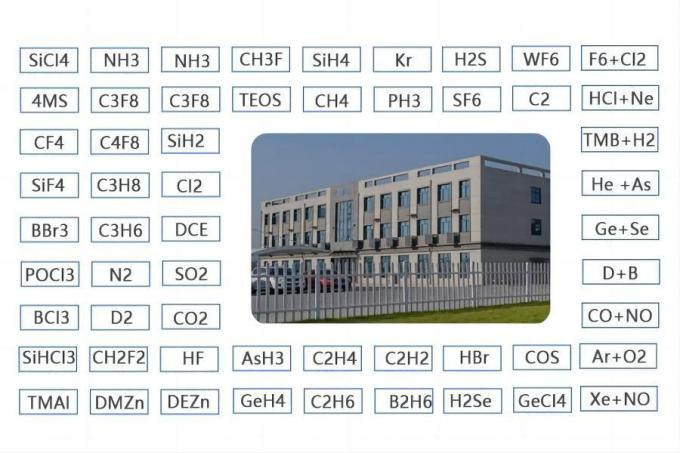


| MOQ: | 1kg |
| Price: | US $7000/kg |
| Standard Packaging: | Cylinder/Tank |
| Delivery Period: | 15 days |
| Payment Method: | L/C, T/T |
| Supply Capacity: | 5000kg/month |
Hydrogen bromide gas, often represented as HBr(g), is a chemical compound consisting of hydrogen (H) and bromine (Br). It is a colorless gas with a pungent odor. Here are some key points about hydrogen bromide gas:
1. Formation: Hydrogen bromide gas can be formed by the direct combination of hydrogen gas (H₂) and bromine gas (Br₂) under suitable conditions. The reaction is exothermic and typically requires the presence of a catalyst such as iron or platinum.
H₂(g) + Br₂(g) → 2HBr(g)
2. Solubility: Hydrogen bromide gas is highly soluble in water, and it forms hydrobromic acid (HBr) when dissolved. The resulting solution is a strong acid and is commonly used in various chemical reactions and industrial processes.
3. Acidic properties: Hydrogen bromide is an acidic gas, meaning it can donate a proton (H⁺) when dissolved in water. Hydrobromic acid, formed by the dissolution of HBr in water, is a strong acid and dissociates completely, releasing hydrogen ions (H⁺) and bromide ions (Br⁻).
HBr(g) + H₂O(l) → H₃O⁺(aq) + Br⁻(aq)
4. Reactivity: Hydrogen bromide gas is a reactive compound. It can react with various substances, including metals, bases, and alkalis, to form different compounds. For example, it reacts with metals to produce bromides and hydrogen gas:
2HBr(g) + Mg(s) → MgBr₂(s) + H₂(g)
5. Uses: Hydrogen bromide gas and its derivatives have several applications. It is used in organic synthesis, particularly in the production of pharmaceuticals, dyes, and perfumes. Hydrobromic acid is also used in the manufacture of inorganic bromides, as a catalyst, and in the purification of certain gases.
6. Safety precautions: Hydrogen bromide gas is corrosive and can cause severe burns. It is toxic if inhaled or ingested, and exposure to high concentrations should be avoided. Proper safety measures, such as adequate ventilation and protective equipment, should be used when handling or working with hydrogen bromide gas or its solutions.
It's important to note that working with hydrogen bromide gas requires specialized knowledge and proper safety protocols. If you have any specific questions or concerns about hydrogen bromide gas or its applications, it is recommended to consult with experts or refer to appropriate reference materials.
Basic Info.
| Model No: | HBr | Transport Package | Cylinder |
| Specification: | 10L/47L | Trademark | CMC |
| Origin: | Suzhou | HS Code | 2811299000 |
| Production Capacity: | 600t/Year |
| Product name | Hydrogen bromide |
| Type | HBr |
| Purity | n5.0 |
| Cylinder Spec | 10L / 47L |
| Fill contens (20?C) | 10kg / 50kg |
| Fill pressure (20?C,-5%) | 23 bar |
| Valve type | DISS 634 |
| Applications | Semiconductor: gas phase etching gas. |
Detailed Photos





| MOQ: | 1kg |
| Price: | US $7000/kg |
| Standard Packaging: | Cylinder/Tank |
| Delivery Period: | 15 days |
| Payment Method: | L/C, T/T |
| Supply Capacity: | 5000kg/month |
Hydrogen bromide gas, often represented as HBr(g), is a chemical compound consisting of hydrogen (H) and bromine (Br). It is a colorless gas with a pungent odor. Here are some key points about hydrogen bromide gas:
1. Formation: Hydrogen bromide gas can be formed by the direct combination of hydrogen gas (H₂) and bromine gas (Br₂) under suitable conditions. The reaction is exothermic and typically requires the presence of a catalyst such as iron or platinum.
H₂(g) + Br₂(g) → 2HBr(g)
2. Solubility: Hydrogen bromide gas is highly soluble in water, and it forms hydrobromic acid (HBr) when dissolved. The resulting solution is a strong acid and is commonly used in various chemical reactions and industrial processes.
3. Acidic properties: Hydrogen bromide is an acidic gas, meaning it can donate a proton (H⁺) when dissolved in water. Hydrobromic acid, formed by the dissolution of HBr in water, is a strong acid and dissociates completely, releasing hydrogen ions (H⁺) and bromide ions (Br⁻).
HBr(g) + H₂O(l) → H₃O⁺(aq) + Br⁻(aq)
4. Reactivity: Hydrogen bromide gas is a reactive compound. It can react with various substances, including metals, bases, and alkalis, to form different compounds. For example, it reacts with metals to produce bromides and hydrogen gas:
2HBr(g) + Mg(s) → MgBr₂(s) + H₂(g)
5. Uses: Hydrogen bromide gas and its derivatives have several applications. It is used in organic synthesis, particularly in the production of pharmaceuticals, dyes, and perfumes. Hydrobromic acid is also used in the manufacture of inorganic bromides, as a catalyst, and in the purification of certain gases.
6. Safety precautions: Hydrogen bromide gas is corrosive and can cause severe burns. It is toxic if inhaled or ingested, and exposure to high concentrations should be avoided. Proper safety measures, such as adequate ventilation and protective equipment, should be used when handling or working with hydrogen bromide gas or its solutions.
It's important to note that working with hydrogen bromide gas requires specialized knowledge and proper safety protocols. If you have any specific questions or concerns about hydrogen bromide gas or its applications, it is recommended to consult with experts or refer to appropriate reference materials.
Basic Info.
| Model No: | HBr | Transport Package | Cylinder |
| Specification: | 10L/47L | Trademark | CMC |
| Origin: | Suzhou | HS Code | 2811299000 |
| Production Capacity: | 600t/Year |
| Product name | Hydrogen bromide |
| Type | HBr |
| Purity | n5.0 |
| Cylinder Spec | 10L / 47L |
| Fill contens (20?C) | 10kg / 50kg |
| Fill pressure (20?C,-5%) | 23 bar |
| Valve type | DISS 634 |
| Applications | Semiconductor: gas phase etching gas. |
Detailed Photos



